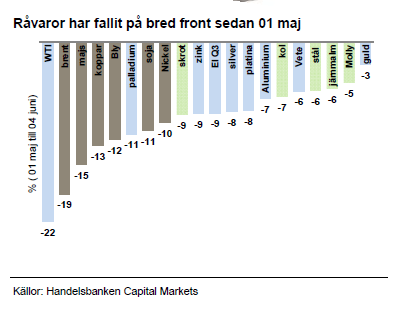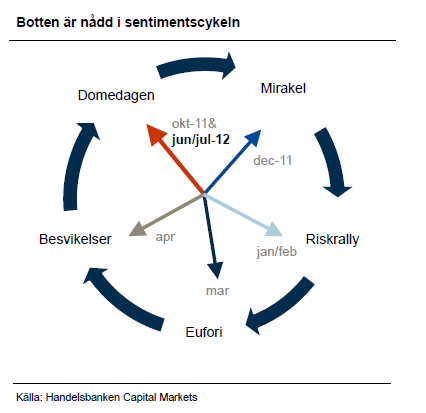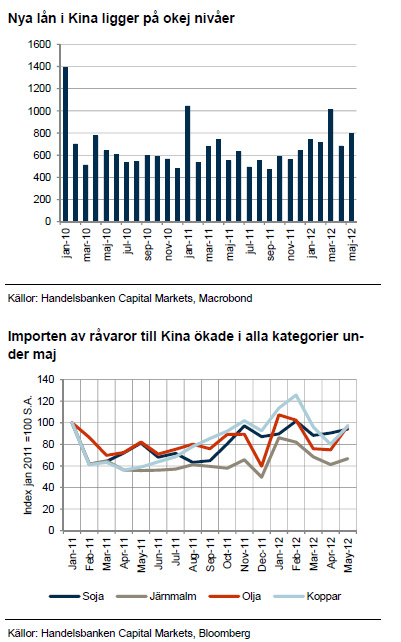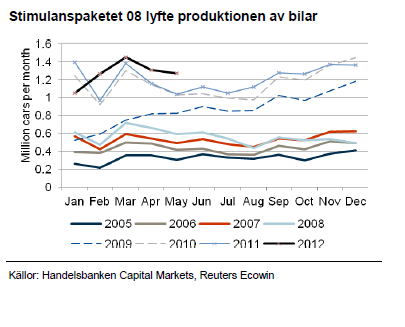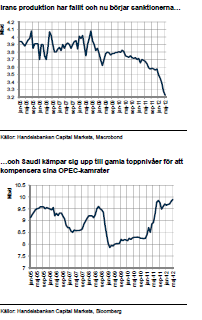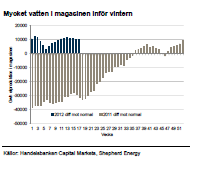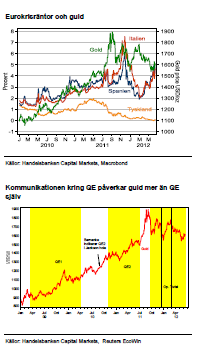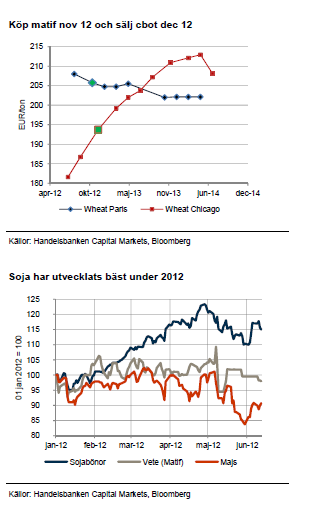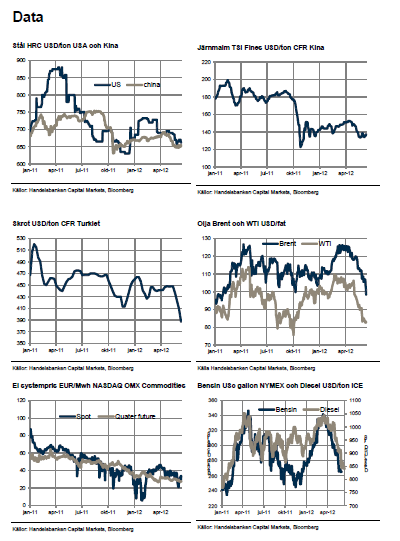Analys
SHB Råvaruplanket 19 juni 2012
 Sedan i mars har vi argumenterat för en svagare råvarumarknad och vi har legat kort både energi, livsmedel och basmetaller sedan i april, vilket gjort att vår syn på vårt breda råvaruindex har varit sälj. Under våren har det skett en inbromsning i utsikterna för tillväxt i Europa simultant med att makrodata i Kina har bekräftat en starkare inbromsning än vad som var förväntat. I den här miljön har råvaror handlats på makroekonomiska utsikter och investerares sentiment snarare än råvarornas egen fundamenta, vilket gjort dem korrelerade med aktiemarknaden. I grafen till höger ses prisfallen under maj. De grå staplarna visar att kinaexponerade råvaror har fallit mest efter olja som är investerares största råvaruinnehav. De gröna staplarna visar råvaror som inte är åtkomliga för investerare. Att de gröna har fallit indikerar att realekonomin är negativt påverkad. Fallet beror alltså på sämre realekonomi och sämre risksentiment. Vi tror att båda faktorerna nått sin botten och nu ska man återinträda breda råvaruexponeringar.
Sedan i mars har vi argumenterat för en svagare råvarumarknad och vi har legat kort både energi, livsmedel och basmetaller sedan i april, vilket gjort att vår syn på vårt breda råvaruindex har varit sälj. Under våren har det skett en inbromsning i utsikterna för tillväxt i Europa simultant med att makrodata i Kina har bekräftat en starkare inbromsning än vad som var förväntat. I den här miljön har råvaror handlats på makroekonomiska utsikter och investerares sentiment snarare än råvarornas egen fundamenta, vilket gjort dem korrelerade med aktiemarknaden. I grafen till höger ses prisfallen under maj. De grå staplarna visar att kinaexponerade råvaror har fallit mest efter olja som är investerares största råvaruinnehav. De gröna staplarna visar råvaror som inte är åtkomliga för investerare. Att de gröna har fallit indikerar att realekonomin är negativt påverkad. Fallet beror alltså på sämre realekonomi och sämre risksentiment. Vi tror att båda faktorerna nått sin botten och nu ska man återinträda breda råvaruexponeringar.
Osäkerhet består i realekonomin
Med osäkerhet i Kina, Europa och kommande osäkerhet i USA inför sparprogrammen efter valet i november så söker vi inte gamla toppnivåer för råvarorna. Från nuvarande nivåer finns det emellertid mycket som talar för uppgång. Råvarorna kommer dock fortsätta åka i baksätet med makro och risksentiment i framsätet och därför tror vi att en bra strategi för de kommande månaderna är att köpa under de svagaste dagarna och sälja när priserna rallat. Den här strategin håller vi fast vid tills Kina fått fotfäste och/eller det kommer (o)väntad stimulans från Europa och/eller USA.
Pessimistiskt sentiment ger stöd
Vi hittar mycket som talar för att vi är nära botten i sentimentcykeln. Det ser alltid som mörkast ut när det vänder. Efter att Spanien sökt nödlån för sina banker och Ny Demokrati vunnit valet i Grekland så är de två största eventriskerna i Europa undanröjda för ett tag framöver.
Basmetaller
”Sämre än väntat” har spelat ut
Sedan i mars har vi argumenterat för att basmetaller skulle falla baserat på att Kinas ekonomi skulle bromsa mer än väntat. Det är fortfarande för tidigt att dra tunga växlar på konjunkturåterhämtning och att priserna kommer stiga dramatiskt men vi tror att nedsidan är begränsad från dessa nivåer och med den draghjälp Kinas konjunktur får från stimulanser sedan i maj. Efter några månader med klart sämre data än väntat så vände importen av järnmalm, olja, koppar och sojabönor upp under maj. Det säger inte så mycket om efterfrågan som att likviditeten slutligen har börjat öka efter de tre sänkningarna av reservkraven som gjorts sedan november och nu senast även en räntesänkning. Det kan också betyda att lager har betats av och att Kina står inför att fylla på lagerkedjan igen. Nya lån har legat på bra nivåer hela året och garanterat kredittillväxt, samtidigt har inflationen pressats ner av den sämre konjunkturen och håller inte längre tillbaka stimulanser på samma vis som tidigare. Vi förväntade oss inget stimulanspaket likt det som kom 2008 och gör det fortfarande inte. Fastighetsmarknaden kommer också att vara fortsatt pressad och politiker fortsätter säga att de vill se lägre priser på fastigheter. De stimulanser som kommit har förhållandevis varit tyngre viktade mot konsumtionsvaror (hushållsmaskiner och bilar) jämfört med 2008. Det betyder relativt mer nickel och bly och relativt mindre stål, koppar och zink jämfört med paketet som kom 2008. Förra paketet lyfte bilproduktionen rejält och vi förväntar oss fortsatt styrka med stöd av det nya paketet. Bly används numera till 75 % i bilbatterier.
Inför ett starkare H2
Lättnader, stimulanser, likviditet och lagercykeln tyder på att Kinas fundamentala behov av råvaror åter kommer att öka under andra halvåret. Ackompanjerat av investerares återinträde i råvaror så tror vi att basmetaller generellt kommer att stiga från dagens nivåer. Nickel är den basmetall som tryckts ner mest i utflödet och vi favoriserar nickel. Intressanta spreadar är nickel mot basmetallkorgen eller nickel mot koppar.
Lång nickel, bly och basmetallkorgen
Lång nickel mot 1,15 basmetallkorg (nickel har högt beta mot korgen)
Lång nickel mot koppar
Energi
Upp som en sol ner som en pannkaka
Brentoljan inledde året med ett rally på krigsrubriker i Iran. Israel ville undanröja Irans möjligheter att anrika uran till kärnvapennivå. Europa och USA gav Israel sitt stöd och Iran hotade att stänga Hormuzsundet med millitär. EU och USA införde sanktioner mot Irans olja från och med juli och Brent handlades upp till 128 dollar inklusive en ordentlig riskpremie från trendföljande investerare i mars.
Fundamenta på oljemarknaden har sedan dess svängt snabbt. OECDs lager är nu välfyllda från att varit nära 5 – års lägsta i februari. Anledningen är högre produktion och inte fallande efterfrågan. Produktionen i USA och Kanada har stigit och OPEC har ökat 1 Mb/d i Libyen och Irak. Saudi har legat nära 10 Mb/d (30-års högsta) under året och Irans borfall på 0,6-0,8 Mb/d har inte märkts på sista raden. OPEC har 30 Mb/d som mål men har producerat 31,6 Mb/d under året på grund av att Saudi vill få ner priset från skadliga nivåer.
Kina kompenserar för fallande efterfrågan i Europa och USA och Japan ersätter den nedlagda kärnkraften med oljeeldade kraftverk. Därtill kommer sanktionerna mot Iran nu att inträda rent fysiskt från 01 juli. Trots de svagare makroutsikterna sänker vi därför inte den globala efterfrågan, skulle överproduktionen hålla i sig kommer OPEC att minska ganska snart. Därför tror vi att priserna kommer hämta sig från nedtryckta nivåer med en prognos på 110 dollar för andra halvåret 2012.
Nu handlar SHB Power mot Q4 terminspris
Den milda vintern med en blöt vår har gjort att vattenmagasinen är välfyllda inför den kalla perioden. Kolpriserna driver marginalkostnaden för produktionen under vintern. Idag handlas Q4an kring priset då kolkraften kopplas in vilket betyder att kolkraften snabbt kommer in i prisbilden om sommaren blir torr och vattenreserverna krymper eller om underhållsperioden för någon av kärnreaktorerna förlängs. Omvänt kommer priset att falla om sommaren blir blöt och bibehåller höga vattennivåer i magasinen. Båda scenarierna är svåra att sia om (det finns ingen statistiskt säkerställd väderprognos som varar längre än 5-6 dagar). I år föreligger inte samma höga risk för bortfall från kärnkraften då man skjutit de omfattande planerna att höja kapaciteten i vissa reaktorer.
Lång Brent, Neutral El, Bensin och Diesel
Ädelmetaller
Feds språk om QE har styrt guld
Guld har i relativa termer stått emot marknadens nedgång under våren mycket bra men har i absoluta tal tappat några procent. Guld har åter visat sig vara okorrelerat med det mesta men har såklart lidit av den starkare dollarn. Den tidigare kopplingen till europakrisen har varit svagare medan de största rörelserna har inträffat vid förändringar i förväntningarna på QE.
Europas problem består
I takt med att bankproblemen har eskalerat, främst iSpanien så har trycket på ECB att stödja eurozonen ökat. Räntesänkning i juni och LTRO3 är under uppsegling till hösten. LTRO 3 borde ha en liknande effekt på guld och silver som QE haft, även om den inte sänker dollarn så bidrar den till högre inflationsförväntningar och ökad likviditet. Silver har följt gulds trender men med avsevärt större rörelser. Silver har under året haft ett dagligt beta mot guld på 1,56! Guld och silver är intressanta som icke korrelerade tillgångar i portföljen. Med ett okontrollerat uppbrott av EMU samarbetet framför oss det kommande året ser vi inga skäl att inte köpa dessa ädla metaller även om de må vara notoriskt svårprognostiserade.
Platina och Palladium-brist men på sikt
Även då de båda ädla industrimetallerna är på väg mot ett stort underskott i spåren av höjda krav på att minska NO2 i Europa så har metallerna inte stått emot fallet under maj. De nya EU direktiven gäller från årsskiftet och har tvingat fordonsindustrin att utveckla nya motorer med avsevärt mer palladium och platina för att möta utsläppsnivåerna för tunga fordon.
Platina används till dieselmotorer medan palladium dominerar i katalysatorerna på bensinmotorer. Den svaga industriella utvecklingen i Europas fordonsindustri som är världens största tillverkare av dieselfordon kan leda till att platina utvecklas starkare än palladium framöver.
Lång guld och silver
Neutral palladium och platina
Livsmedel
Vintern är över
Med den varma vintern och tidiga sådden i USA har de tre stora grödorna prognostiseras nå stora skördar i år. Det fick oss att dra ner majs och vete medan soja såg fortsatt starkt ut med Kinas stora import som drivkraft. Efter att oron för hur grödorna övervintrat bekräftats obefogade så har vädret i Europa och vissa områden av svarta havet varit allt för torrt för en optimal utveckling av grödorna. Speciellt europeiskt vete har handlats upp och ner på Europas torka.
Majs har drivit vete
Den möjliga substitutionen mellan majs och vete till djurfoder gör att när majs handlas på höga nivåer så ger det stöd till vete. Vete i sig har bra lagernivåer och nuvarande veteskörd ser ut att bli bra i USA. Jämfört med i förra ”Råvaruplanket” så tycker vi att det finns skäl att vara mer positiv till vete i Europa på ökad risk för lägre produktion i Östeuropa och även i de gamla sovjetländerna. Stora risker finns i Ryssland. De södra delarna lider av torka och är också de områden där vete för exportmarknaden odlas. Om inte regn kommer snart kommer det leda till lägre skörd och export. Eftersom USA väntas få en väldigt bra skörd kan detta driva spreaden mellan europeiskt vete på Matif och vete i Chicago.
Optimalt för majs i år
Sådden av majs i USA har gått snabbt, tillsammans med goda väderförutsättningar borgar det för en stor och framförallt tidig skörd. Det kan göra att årets majsskörd kan börja användas före fjolårets är slut. Om nuvarande förutsättningar består kommer skörden bli utmärkt och prispress uppstå. Vi fortsätter därför att tro på lägre priser och därmed ett sämre stöd till vete via substitutionseffekten.
Sojan fortsatt stark
Sedan en tid tillbaka har sojabönorna utvecklats klart bäst prismässigt av de tre stora grödorna och det finns i dagsläget inga direkta skäl till en nedgång. Den sydamerikanska skörden har justerats ned ytterligare. Brist på väta i Södra Brasilien, Paraguay och Norra Argentina har sänkt skörden. Det starka importtycket från Kina håller efterfrågan uppe och vi tror att säsongens högsta sojapris kommer mellan juni och augusti då de globala lagren kommer vara som lägst före skörden av sojabönor kommer i gång i USA.
Lång vete matif nov 12 mot vete cbot dec 12
[box]SHB Råvaruplanket är producerat av Handelsbanken och publiceras i samarbete och med tillstånd på Råvarumarknaden.se[/box]
Ansvarsbegränsning
Detta material är producerat av Svenska Handelsbanken AB (publ) i fortsättningen kallad Handelsbanken. De som arbetar med innehållet är inte analytiker och materialet är inte oberoende investeringsanalys. Innehållet är uteslutande avsett för kunder i Sverige. Syftet är att ge en allmän information till Handelsbankens kunder och utgör inte ett personligt investeringsråd eller en personlig rekommendation. Informationen ska inte ensamt utgöra underlag för investeringsbeslut. Kunder bör inhämta råd från sina rådgivare och basera sina investeringsbeslut utifrån egen erfarenhet.
Informationen i materialet kan ändras och också avvika från de åsikter som uttrycks i oberoende investeringsanalyser från Handelsbanken. Informationen grundar sig på allmänt tillgänglig information och är hämtad från källor som bedöms som tillförlitliga, men riktigheten kan inte garanteras och informationen kan vara ofullständig eller nedkortad. Ingen del av förslaget får reproduceras eller distribueras till någon annan person utan att Handelsbanken dessförinnan lämnat sitt skriftliga medgivande. Handelsbanken ansvarar inte för att materialet används på ett sätt som strider mot förbudet mot vidarebefordran eller offentliggörs i strid med bankens regler.
Analys
Tightening fundamentals – bullish inventories from DOE

The latest weekly report from the US DOE showed a substantial drawdown across key petroleum categories, adding more upside potential to the fundamental picture.

Commercial crude inventories (excl. SPR) fell by 5.8 million barrels, bringing total inventories down to 415.1 million barrels. Now sitting 11% below the five-year seasonal norm and placed in the lowest 2015-2022 range (see picture below).
Product inventories also tightened further last week. Gasoline inventories declined by 2.1 million barrels, with reductions seen in both finished gasoline and blending components. Current gasoline levels are about 3% below the five-year average for this time of year.
Among products, the most notable move came in diesel, where inventories dropped by almost 4.1 million barrels, deepening the deficit to around 20% below seasonal norms – continuing to underscore the persistent supply tightness in diesel markets.
The only area of inventory growth was in propane/propylene, which posted a significant 5.1-million-barrel build and now stands 9% above the five-year average.
Total commercial petroleum inventories (crude plus refined products) declined by 4.2 million barrels on the week, reinforcing the overall tightening of US crude and products.


Analys
Bombs to ”ceasefire” in hours – Brent below $70

A classic case of “buy the rumor, sell the news” played out in oil markets, as Brent crude has dropped sharply – down nearly USD 10 per barrel since yesterday evening – following Iran’s retaliatory strike on a U.S. air base in Qatar. The immediate reaction was: “That was it?” The strike followed a carefully calibrated, non-escalatory playbook, avoiding direct threats to energy infrastructure or disruption of shipping through the Strait of Hormuz – thus calming worst-case fears.

After Monday morning’s sharp spike to USD 81.4 per barrel, triggered by the U.S. bombing of Iranian nuclear facilities, oil prices drifted sideways in anticipation of a potential Iranian response. That response came with advance warning and caused limited physical damage. Early this morning, both the U.S. President and Iranian state media announced a ceasefire, effectively placing a lid on the immediate conflict risk – at least for now.
As a result, Brent crude has now fallen by a total of USD 12 from Monday’s peak, currently trading around USD 69 per barrel.
Looking beyond geopolitics, the market will now shift its focus to the upcoming OPEC+ meeting in early July. Saudi Arabia’s decision to increase output earlier this year – despite falling prices – has drawn renewed attention considering recent developments. Some suggest this was a response to U.S. pressure to offset potential Iranian supply losses.
However, consensus is that the move was driven more by internal OPEC+ dynamics. After years of curbing production to support prices, Riyadh had grown frustrated with quota-busting by several members (notably Kazakhstan). With Saudi Arabia cutting up to 2 million barrels per day – roughly 2% of global supply – returns were diminishing, and the risk of losing market share was rising. The production increase is widely seen as an effort to reassert leadership and restore discipline within the group.
That said, the FT recently stated that, the Saudis remain wary of past missteps. In 2018, Riyadh ramped up output at Trump’s request ahead of Iran sanctions, only to see prices collapse when the U.S. granted broad waivers – triggering oversupply. Officials have reportedly made it clear they don’t intend to repeat that mistake.
The recent visit by President Trump to Saudi Arabia, which included agreements on AI, defense, and nuclear cooperation, suggests a broader strategic alignment. This has fueled speculation about a quiet “pump-for-politics” deal behind recent production moves.
Looking ahead, oil prices have now retraced the entire rally sparked by the June 13 Israel–Iran escalation. This retreat provides more political and policy space for both the U.S. and Saudi Arabia. Specifically, it makes it easier for Riyadh to scale back its three recent production hikes of 411,000 barrels each, potentially returning to more moderate increases of 137,000 barrels for August and September.
In short: with no major loss of Iranian supply to the market, OPEC+ – led by Saudi Arabia – no longer needs to compensate for a disruption that hasn’t materialized, especially not to please the U.S. at the cost of its own market strategy. As the Saudis themselves have signaled, they are unlikely to repeat previous mistakes.
Conclusion: With Brent now in the high USD 60s, buying oil looks fundamentally justified. The geopolitical premium has deflated, but tensions between Israel and Iran remain unresolved – and the risk of missteps and renewed escalation still lingers. In fact, even this morning, reports have emerged of renewed missile fire despite the declared “truce.” The path forward may be calmer – but it is far from stable.
Analys
A muted price reaction. Market looks relaxed, but it is still on edge waiting for what Iran will do

Brent crossed the 80-line this morning but quickly fell back assigning limited probability for Iran choosing to close the Strait of Hormuz. Brent traded in a range of USD 70.56 – 79.04/b last week as the market fluctuated between ”Iran wants a deal” and ”US is about to attack Iran”. At the end of the week though, Donald Trump managed to convince markets (and probably also Iran) that he would make a decision within two weeks. I.e. no imminent attack. Previously when when he has talked about ”making a decision within two weeks” he has often ended up doing nothing in the end. The oil market relaxed as a result and the week ended at USD 77.01/b which is just USD 6/b above the year to date average of USD 71/b.

Brent jumped to USD 81.4/b this morning, the highest since mid-January, but then quickly fell back to a current price of USD 78.2/b which is only up 1.5% versus the close on Friday. As such the market is pricing a fairly low probability that Iran will actually close the Strait of Hormuz. Probably because it will hurt Iranian oil exports as well as the global oil market.
It was however all smoke and mirrors. Deception. The US attacked Iran on Saturday. The attack involved 125 warplanes, submarines and surface warships and 14 bunker buster bombs were dropped on Iranian nuclear sites including Fordow, Natanz and Isfahan. In response the Iranian Parliament voted in support of closing the Strait of Hormuz where some 17 mb of crude and products is transported to the global market every day plus significant volumes of LNG. This is however merely an advise to the Supreme leader Ayatollah Ali Khamenei and the Supreme National Security Council which sits with the final and actual decision.
No supply of oil is lost yet. It is about the risk of Iran closing the Strait of Hormuz or not. So far not a single drop of oil supply has been lost to the global market. The price at the moment is all about the assessed risk of loss of supply. Will Iran choose to choke of the Strait of Hormuz or not? That is the big question. It would be painful for US consumers, for Donald Trump’s voter base, for the global economy but also for Iran and its population which relies on oil exports and income from selling oil out of that Strait as well. As such it is not a no-brainer choice for Iran to close the Strait for oil exports. And looking at the il price this morning it is clear that the oil market doesn’t assign a very high probability of it happening. It is however probably well within the capability of Iran to close the Strait off with rockets, mines, air-drones and possibly sea-drones. Just look at how Ukraine has been able to control and damage the Russian Black Sea fleet.
What to do about the highly enriched uranium which has gone missing? While the US and Israel can celebrate their destruction of Iranian nuclear facilities they are also scratching their heads over what to do with the lost Iranian nuclear material. Iran had 408 kg of highly enriched uranium (IAEA). Almost weapons grade. Enough for some 10 nuclear warheads. It seems to have been transported out of Fordow before the attack this weekend.
The market is still on edge. USD 80-something/b seems sensible while we wait. The oil market reaction to this weekend’s events is very muted so far. The market is still on edge awaiting what Iran will do. Because Iran will do something. But what and when? An oil price of 80-something seems like a sensible level until something do happen.
-

 Nyheter4 veckor sedan
Nyheter4 veckor sedanUppgången i oljepriset planade ut under helgen
-

 Nyheter3 veckor sedan
Nyheter3 veckor sedanMahvie Minerals växlar spår – satsar fullt ut på guld
-

 Nyheter4 veckor sedan
Nyheter4 veckor sedanLåga elpriser i sommar – men mellersta Sverige får en ökning
-

 Nyheter2 veckor sedan
Nyheter2 veckor sedanOljan, guldet och marknadens oroande tystnad
-

 Analys4 veckor sedan
Analys4 veckor sedanVery relaxed at USD 75/b. Risk barometer will likely fluctuate to higher levels with Brent into the 80ies or higher coming 2-3 weeks
-

 Nyheter2 veckor sedan
Nyheter2 veckor sedanJonas Lindvall är tillbaka med ett nytt oljebolag, Perthro, som ska börsnoteras
-

 Analys3 veckor sedan
Analys3 veckor sedanA muted price reaction. Market looks relaxed, but it is still on edge waiting for what Iran will do
-

 Nyheter2 veckor sedan
Nyheter2 veckor sedanDomstolen ger klartecken till Lappland Guldprospektering


